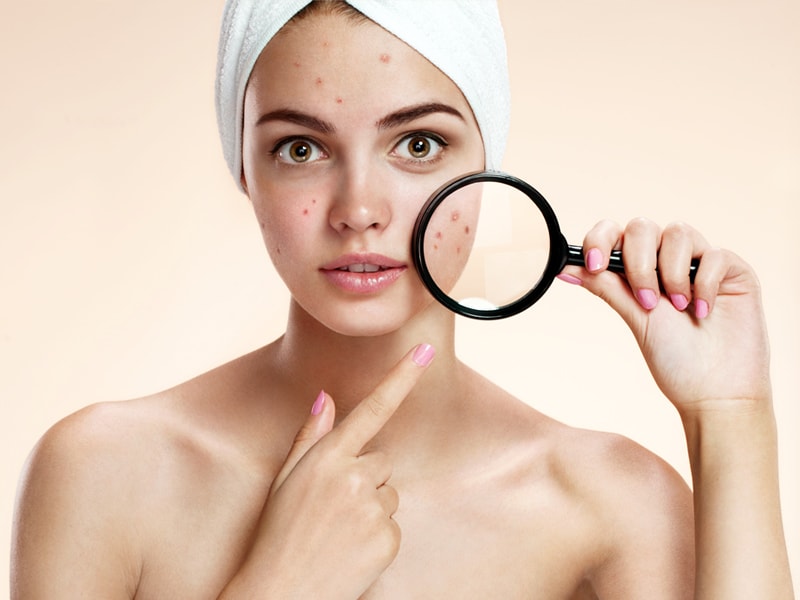You probably wonder how to get rid of unwanted holiday souvenir – discoloration on the face. Do you want to take effective action against skin discoloration? Start using acids.
Discolourations on the face from the sun – where do they come from?
Freckles, moles, spots on the skin – this is really a natural effect of melanin, the substance responsible for the colour of your skin. If you haven’t covered yourself with filters and spent a lot of time in the sun, cells can produce more melanin, which will irregularly decompose in your skin. This is how discolouration occurs.
Skin discolourations – who do they occur in?
All right, but not everyone who exposes their face to the sun ends up with ugly spots. So is there such a thing as a predisposition to skin discoloration? Unfortunately, yes!
Skin discoloration and genetics
Under the influence of the sun, discoloration may appear in people who have a genetic predisposition . If any of your family members have sunspots or irregular pigmentation, you should be preventative when you are about to sunbathe.
Skin discoloration and hormonal changes
Hormonal changes are another cause of skin discoloration. Menopausal women are particularly vulnerable to spots and discoloration on the face . Stains may also appear if you are taking birth control pills . Most often, hormonal pigmentation is called chloasma or melasma.
Skin discolourations and medications
Some medications and sunbathing don’t go hand in hand. If you go on holiday and take antibiotics or anti-inflammatory drugs, you should definitely protect your skin from the sun so you don’t get ugly spots.
Skin discolourations and cosmetics
Sometimes, however, the cause of discoloration can be very prosaic – the sun can burn you or react with some cosmetics or even perfumes. That is why it is so important to choose cosmetics that have a UV filter in their composition.
Discolourations from the sun on the face – how to effectively remove them?
Discolouration on the face is not a judgment yet. Of course, you can get rid of them, but it will require your dedication and time.
Aesthetic medicine and hyperpigmentation
The most effective and the fastest, but also the most painful way to remove sun spots are aesthetic medicine treatments. It is best to undergo them in the office of an experienced dermatologist.
What do you have to choose from? Among other things, chemical peelings based on acids, the concentration of which should be adjusted by the doctor individually to the colour of the stain. After the treatment performed in the office for the next few days (up to 5 days after the treatment), your skin will peel off. This means that your face may not look representative during the treatment.
Another method is mesotherapy, which unfortunately involves contact with a needle and syringe. The doctor injects the stain with a healing substance, such as hyaluronic acid, which acts on the stain from the inside.
Microdermabrasion and dermabrasion are medical procedures that will also help you to deal with discolourations. Dermabrasion is performed when the stains are very resistant. The treatment is painful, but it is carried out under anaesthesia. It consists in deep exfoliation of the epidermis.

Acids for sun-darkened faces – how can they help you?
After consulting a dermatologist and excluding the possibility that your hyperpigmentation may endanger your health, you can go to a beautician who will remove stains by means of specialist acid-based treatments. And which acids to choose for sun discoloration?
Especially recommended is a treatment based on almond acid. Such a peeling is very delicate, so you can use it even if you have a capillary or sensitive skin. After the peeling the skin is clearly lightened and refreshed.
Cosmetics for sun discolourations with acids – what to choose?
You can try to remove some of the discolourations yourself at home. Reach for cosmetics (e.g. creams or masks) that are designed for this purpose and contain acids. Remember, however, that it will be a long-term process and will require patience and consistency.
Cream for sun discoloration with acids
You should start your skin care with hyperpigmentation by choosing the right cream for facial hyperpigmentation, preferably with acids (e.g. Thiospot ultra, lightening cream for skin changes, SPF 50+ with lactic acid and a-lipid acid +EFA) or retinol (e.g. La roche Redermic R), which will lighten the sun’s changes.
Remember to choose a cream with acid for hyperpigmentation adapted to your skin type.Apply the discolouration cream to the face at least once a day only to the darker area of the skin, otherwise your “normal” skin will also lighten up. Do not expose your skin to the sun during the treatment.
Serum for discoloration
A much better brightening effect is achieved when you reach for a concentrated day serum, such as Ducray Melascreen Serum Intensive Depigmentation, which contains glycolic acid. You can apply them up to twice a day.
Nighttime cosmetics for sun discolourations
If you prefer more concentrated and heavier night cosmetics, I recommend Pharmaceris W, Acipeel 3x, a depigmenting hyperpigmentation serum that combines the power of three brightening and exfoliating acids – citric, almond and salicylic acid, or Bioderma White Objective, a night-time serum that reduces hyperpigmentation based on vitamin C and glycolic acid.
Whatever method you choose to lighten your sun spots, don’t make your face sour. Simply rely on acids to restore your skin’s natural and uniform colour.

